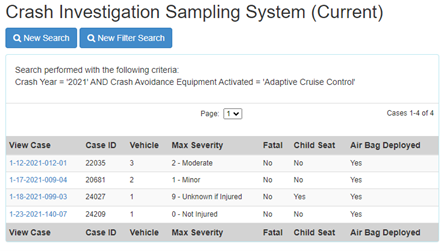Since the early 1970s, the National Highway Traffic Safety Administration (NHTSA) has collected crash data to evaluate traffic safety issues such as driver performance, crash worthiness, and the effects of new technologies on crash amelioration. As part of this mandate, the Crash Investigation Sampling System (CISS) collects and disseminates real-world crash data relating to primary causation factors and their related injury outcome.
What is CISS?
NHTSA’s website describes CISS as “a probability-based sampling program that produces nationally representative probability samples of police-reported motor vehicle crashes where at least one passenger vehicle was towed from the scene for any reason. Trained crash technicians obtain data from 32 crash sites by documenting scene evidence, inspecting the vehicles involved, interviewing crash victims and reviewing crash victims’ medical records to determine the nature and severity of the crash-related injuries.”
How is the Information Used?
The data collected and assimilated by CISS is made available to other Federal agencies, safety advocates, research institutions, regulators, and the general public for improving overall transportation safety. The data enables stakeholders to develop informed protocols regarding key traffic safety issues.
CISS data is publicly accessible through NHTSA’s “Crash Viewer,” where the data can be searched and filtered by various attributes such as crash date, severity, make and model of the involved vehicles, and even the type of crash avoidance equipment that was activated at the time of the crash. For example, a search of CISS data from crashes that occurred in 2021 while Adaptive Cruise Control (ACC) was activated returns the following:
Keep in mind that this does not represent all crashes that occurred in 2021 while ACC was activated, but only the crashes that were investigated within the CISS program and included in the CISS database—a limitation that NHTSA is attempting to remedy through a proposed expansion.
What is the Proposed Expansion of CISS?
Due to its present size and staffing, CISS is only able to investigate approximately 4,000 crashes annually. Given that more than 6 million accidents occur in the US each year, this relatively small sample size is not ideal for meaningful analysis of new or emerging crash trends. Additionally, CISS currently only has the capacity to select designated crashes for investigation 3-7 days post event. By that time, according to NHTSA, “critical evidence from the scene can be destroyed, altered or removed, vehicles can be hard to locate or repaired, and people involved tend to forget information related to the crash.”
To address the above limitations, NHTSA is currently “pursuing data improvement initiatives that will enhance the amount of data collected and the quality of the data collected in CISS” as authorized by Congress under § 24108(e) of the Bipartisan Infrastructure Law of 2021. This major effort to upgrade CISS will focus on expanding data collection sites and providing additional resources to improve investigation protocols and data collection methods. These changes should substantially increase the quantity and efficacy of CISS crash investigations, thereby reducing variance in key life critical safety estimates.
Is it Enough?
Improvements to CISS are essential to ensure crash investigations are conducted accurately and thoroughly, and that robust data is available to those involved in making our roadways as safe as possible. While NHTSA clearly recognizes these objectives with its proposed expansion of CISS, the program will remain limited if it does not account for the vast amount of data that is being generated by modern vehicles.
The evolution of vehicle technology brings with it enormous potential for greater efficiency and objectivity in the investigation of vehicle collisions. CISS should leverage advances in mobility and automotive technology, including advances in connectivity, automation, electrification, traffic management, and data storage, to fully understand the collisions it investigates. By utilizing these emerging resources, CISS can eliminate the inaccuracies of manual investigations and bring speed, objectivity, efficiency, and tremendous cost savings to its investigative process.
NHTSA has already realized the benefits of this type of data in crash investigations to some extent through Standing General Order 2021-01 (SGO), issued in June 2021, which requires automakers to submit data regarding crashes that occur while Level 2 ADAS and Level 3+ automation features are engaged. As amended, the SGO requires automakers to comply with these requirements for three years from April 5, 2023, with NHTSA now publishing data reports to the public routinely. These reports have served as important information gathering tools for NHTSA to learn of potential safety concerns through consistent and timely data collection, but the efforts can and should go farther to fully realize the potential of the available data. NHTSA should view the CISS program expansion as another opportunity to capture vehicle data that is currently underutilized to monitor safety and effectively regulate in the evolving transportation sector.
We applaud NHTSA’s efforts to enhance roadway safety by expanding and improving the tools available to CISS. The data collection and dissemination efforts of CISS are essential components in the fight against vehicle fatalities and threats to public safety, and we will continue to monitor NHTSA’s ongoing efforts in this regard.
Copyright Nelson Niehaus LLC
The opinions expressed in this blog are those of the author(s) and do not necessarily reflect the views of the Firm, its clients, or any of its or their respective affiliates. This blog post is for general information purposes and is not intended to be and should not be taken as legal advice.

